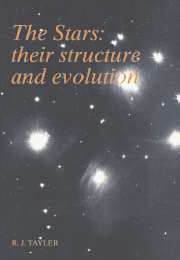Book contents
- Frontmatter
- Contents
- Preface
- Symbols
- Numerical values
- 1 Introduction
- 2 Observational properties of stars
- 3 The equations of stellar structure
- 4 The physics of stellar interiors
- 5 The structure of main sequence stars and pre-main-sequence evolution
- 6 Early post-main-sequence evolution and the ages of star clusters
- 7 Mass loss from stars
- 8 Close binary stars
- 9 Advanced evolutionary phases
- 10 The final stages of stellar evolution: white dwarfs, brown dwarfs, neutron stars and black holes
- 11 Concluding remarks
- Appendix 1 Thermodynamic equilibrium
- Appendix 2 The equation of radiative transfer
- Appendix 3 The pressure of a degenerate gas
- Suggestions for further reading
- Index
9 - Advanced evolutionary phases
Published online by Cambridge University Press: 05 June 2012
- Frontmatter
- Contents
- Preface
- Symbols
- Numerical values
- 1 Introduction
- 2 Observational properties of stars
- 3 The equations of stellar structure
- 4 The physics of stellar interiors
- 5 The structure of main sequence stars and pre-main-sequence evolution
- 6 Early post-main-sequence evolution and the ages of star clusters
- 7 Mass loss from stars
- 8 Close binary stars
- 9 Advanced evolutionary phases
- 10 The final stages of stellar evolution: white dwarfs, brown dwarfs, neutron stars and black holes
- 11 Concluding remarks
- Appendix 1 Thermodynamic equilibrium
- Appendix 2 The equation of radiative transfer
- Appendix 3 The pressure of a degenerate gas
- Suggestions for further reading
- Index
Summary
Introduction
In Chapter 6 I have given an account of calculations of stellar evolution away from the main sequence. These calculations have not followed a star through its entire life history except approximately in the case of those low mass stars which do not burn their hydrogen and helium before their central temperatures cease to rise and the star as a whole then cools down and eventually ceases to be luminous. For more massive stars there are several evolutionary stages after those which have been discussed in Chapter 6.
It is difficult to calculate the evolution of a star all the way from its initial main sequence state to the end of its life history. There are many reasons why this should be so. One important difficulty is that in all calculations errors tend to accumulate. The numerical processes used in solving differential equations can never be completely accurate and over a long period of integration these mathematical errors tend to pile up. In addition, the mathematical expressions for the physical laws are only approximate. In many cases the physical processes which occur in stars cannot be observed directly in the laboratory and in the case of stellar convection there is neither a good theory nor a good experiment. The uncertainties in the internal structure of a star and particularly in its observed properties may be small when it is on or near to the main sequence, but they might lead to the prediction of an incorrect physical process at a later stage.
- Type
- Chapter
- Information
- The StarsTheir Structure and Evolution, pp. 188 - 206Publisher: Cambridge University PressPrint publication year: 1994

